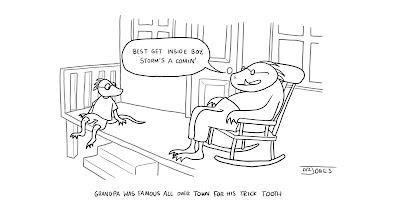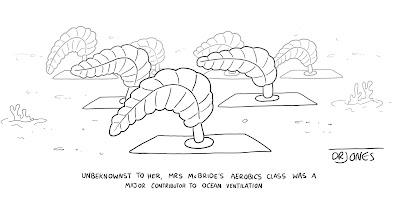 Ellis Jones realizó su doctorado en la Universidad de Manchester estudiando biomarcadores fósiles, específicamente rastros químicos de color original en tejidos blandos como la piel y las plumas. Comenzó a dibujar cómics mientras estaba en Manchester, concretamente historias sobre su grupo de investigación en las que aparecía un "superhéroe" llamado Major Mass Spec. Tras el doctorado, permaneció en Manchester durante algunos años como técnico de investigación y durante ese tiempo empezó a dibujar cómics en conferencias, resumiendo el tema central de la charla en una viñeta humorística. Desde entonces, esto se ha convertido en una forma de seguir en conexión con la comunidad paleontológica, ya que lamentablemente no trabaja en paleontología en la actualidad. De esta forma, se ha convertido en la mejor excusa para acudir a sus conferencias favoritas y estar en contacto con sus compañeros paleontólogos. A continuación dejamos algunas de las viñetas que fue publicando The Palaeontological Association en su cuenta de twitter durante su último congreso celebrado en Cambridge:
Ellis Jones realizó su doctorado en la Universidad de Manchester estudiando biomarcadores fósiles, específicamente rastros químicos de color original en tejidos blandos como la piel y las plumas. Comenzó a dibujar cómics mientras estaba en Manchester, concretamente historias sobre su grupo de investigación en las que aparecía un "superhéroe" llamado Major Mass Spec. Tras el doctorado, permaneció en Manchester durante algunos años como técnico de investigación y durante ese tiempo empezó a dibujar cómics en conferencias, resumiendo el tema central de la charla en una viñeta humorística. Desde entonces, esto se ha convertido en una forma de seguir en conexión con la comunidad paleontológica, ya que lamentablemente no trabaja en paleontología en la actualidad. De esta forma, se ha convertido en la mejor excusa para acudir a sus conferencias favoritas y estar en contacto con sus compañeros paleontólogos. A continuación dejamos algunas de las viñetas que fue publicando The Palaeontological Association en su cuenta de twitter durante su último congreso celebrado en Cambridge: Evolution in the mesopelagic twilight zone is regulated by a temperature- dependent biological pump (Paul N. Pearson)
Evolution in the mesopelagic twilight zone is regulated by a temperature- dependent biological pump (Paul N. Pearson) Echoes from the past: unveiling deep-time functional dynamics through network analysis (Fernando Blanco)
Echoes from the past: unveiling deep-time functional dynamics through network analysis (Fernando Blanco) The impact of fossil tips on reconstructing trait evolution using phylogenetic comparative methods (Bethany J. Allen)
The impact of fossil tips on reconstructing trait evolution using phylogenetic comparative methods (Bethany J. Allen) Current issues with conodont tissues (Bryan Shirley)
Current issues with conodont tissues (Bryan Shirley) The experimental effects of wave processes on arthropod taphonomy: implications for Lagerstätten and small carbonaceous fossils (Laura Devine)
The experimental effects of wave processes on arthropod taphonomy: implications for Lagerstätten and small carbonaceous fossils (Laura Devine) Reconstructing feeding behaviour and diet in Devonian ctenacanth chondrichthyans using tooth wear analysis and finite element analysis (Merle Greif)
Reconstructing feeding behaviour and diet in Devonian ctenacanth chondrichthyans using tooth wear analysis and finite element analysis (Merle Greif) Fossilization can mislead analyses of phenotypic disparity (Thomas J. Smith)
Fossilization can mislead analyses of phenotypic disparity (Thomas J. Smith) Tooth origins and the convergent evolution of sensory structures (Yara Haridy)
Tooth origins and the convergent evolution of sensory structures (Yara Haridy) Developmental and functional constraints drove ontogenetic change in protective enrolment in an ancient arthropod (Jorge Esteve)
Developmental and functional constraints drove ontogenetic change in protective enrolment in an ancient arthropod (Jorge Esteve) Repeated evolution of extreme sabre-tooth morphology explained by optimality (Tahlia Pollock)
Repeated evolution of extreme sabre-tooth morphology explained by optimality (Tahlia Pollock) Ediacaran marine animal forests and the ventilation of the oceans (Imran A. Rahman)
Ediacaran marine animal forests and the ventilation of the oceans (Imran A. Rahman) Exploring the macroevolutionary impact of ecosystem engineers using an individual-based eco-evolutionary simulation (Luke Parry)
Exploring the macroevolutionary impact of ecosystem engineers using an individual-based eco-evolutionary simulation (Luke Parry) The first plants changed the planet and they used mud to do it (William J. McMahon)
The first plants changed the planet and they used mud to do it (William J. McMahon)

